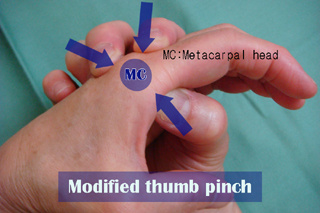 |
Yumoto Orthopaedic Clinic (JP HOME) is the Originator of Percutaneous Trigger Finger Release Surgery with Guided Knife |
Since 2011/07/31 |
|
||||
 |
Yumoto Orthopaedic Clinic (JP HOME) is the Originator of Percutaneous Trigger Finger Release Surgery with Guided Knife |
Since 2011/07/31 |
|
||||
| Palpation of A1 and Flexor - To localize distal margin of A1 pulley - |
Preliminary palpation tests[Manual inspection]Prior to anesthesia, surgeon must obtain full information about A1 pulley and tendon. As for this operation in fact, ultimate reason for manual inspection is to determine the site of distal margin of A1 pulley. 1) Distal margin of A1 pulley When A1 pulley is thick enough, top of the pulley forms steps at both margins. Distal margin is easier to recognize than proximal, and this is one of the reasons that Guided Knife technique initiates division here. 2) Modified thumb pinch  MP joint protrusion (or metacarpal head) as seen from hand dorsum. MP joint protrusion (or metacarpal head) as seen from hand dorsum.There are no medical reports which gave any consideration to metacarpal head as a landmark for PTFR operations so far. Examiner can touch A1 pulley with tip of thumb on the palm and metacarpal head between index and middle fingers on the dorsum. This helps making three-dimensional image of MP joint, of which A1 pulley is a constituent. 3) Tumorous mass and tenderness When you feel a tumor with remarkable tenderness on A1 pulley, it could be a ganglion which needs different operative treatment. 4) Motion of tumorous mass When a tumor could be felt around A1 pulley, make sure it moves or stays according to the motion of the affected finger. 5) Site of triggering It is also important to feel the exact site of friction or vibration sound of locking on active motion of the finger. 6) Pathway of tendon It is not easy to tell whole pathway of the flexor tendon with manual inspection alone. At resisted flexion of a finger, you can recognize the bulge of the flexor tendon just distal to A1 pulley's distal edge. 7) Digital nerves Digital proper nerves could be felt on both sides of flexor tendon Conventional percutaneous trigger finger releases with injection needles have posed hazards for the nerves, especially of thumb Observation of the nerves is important although Guided Knife technique is almost free from this kind of complication when properly performed. 8) Extensor tendon In cases of extensor tendon dislocation at MP joint, locking motion appears like that of trigger fingers. [Ultrasound as a preliminary examination] 1) US (ultrasound) examination is supplementary to manual inspection. 2) It is very easy and useful to observe A1 pulley and flexor tendon on the palm with US. Drawing a landmark with water resistant dye would be beneficial later at operation. 3) US is useful for differential diagnosis of ganglion on A1 pulley. US observation of guide section during LURT is very dicisive to go on division or go back to LURT Manual inspection |